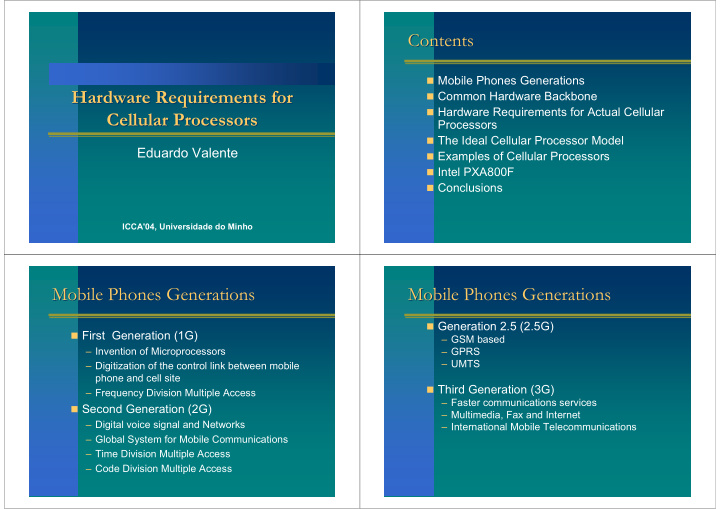



Contents Contents � Mobile Phones Generations Hardware Requirements for Hardware Requirements for � Common Hardware Backbone � Hardware Requirements for Actual Cellular Cellular Processors Cellular Processors Processors � The Ideal Cellular Processor Model Eduardo Valente � Examples of Cellular Processors � Intel PXA800F � Conclusions ICCA'04, Universidade do Minho Mobile Phones Generations Mobile Phones Generations Mobile Phones Generations Mobile Phones Generations � Generation 2.5 (2.5G) � First Generation (1G) – GSM based – Invention of Microprocessors – GPRS – UMTS – Digitization of the control link between mobile phone and cell site � Third Generation (3G) – Frequency Division Multiple Access – Faster communications services � Second Generation (2G) – Multimedia, Fax and Internet – Digital voice signal and Networks – International Mobile Telecommunications – Global System for Mobile Communications – Time Division Multiple Access – Code Division Multiple Access
Hardware Requirements for Actual Hardware Requirements for Actual Common Hardware Backbone Common Hardware Backbone Cellular Processors Cellular Processors � Evolution capacity � Small area Source: CEN Workshop Agreement, April 2003 Hardware Requirements for Actual Hardware Requirements for Actual Hardware Requirements for Actual Hardware Requirements for Actual Cellular Processors Cellular Processors Cellular Processors Cellular Processors � Handle higher bit-rates � High performance � Reduced power consumes � Large application field Courtesy of Jan M. Rabaey Courtesy of Ravi Subramanian - Morphics
The Ideal Cellular Processor Model Examples of Cellular Processors The Ideal Cellular Processor Model Examples of Cellular Processors � Philips' Nexperia – System on Chip design – Media processing and connectivity � Motorola’s i.MX – Applications processors – Advanced floating-point technology � Texas Instruments’s OMAP1710 – Applications processor – DSP engine – supports advanced mobile operating systems such as Linux, Microsoft´s Windows Mobile, … Courtesy of Jan M. Rabaey Intel PXA800F Intel PXA800F Intel PXA800F Intel PXA800F � Intel XScale technology – Process applications and GSM/GPRS protocol stack – Controller of external memory and I/O � Intel MSA technology – DSP applications for GSM/GPRS baseband – General control � OnChip Flash Source: Intel
Intel PXA800F Intel PXA800F Intel PXA800F Intel PXA800F � Parallelism � Integrated Code/data (Flash/SRAM) memories � Reduced System-level latencies � Higher System-level Performance � Reduced System-level power � Lower Energy � Lower Cost for overall platform � Reduced Area for the platform � Reduced RF Edge Rate Noise Effects Conclusions Conclusions � Achievements – Integration / Scalability – High performance in both applications and communication sub-systems – Low latencies – Low energy consumes – Small area – Low Cost � The bounds � Future hardware requirements
Recommend
More recommend